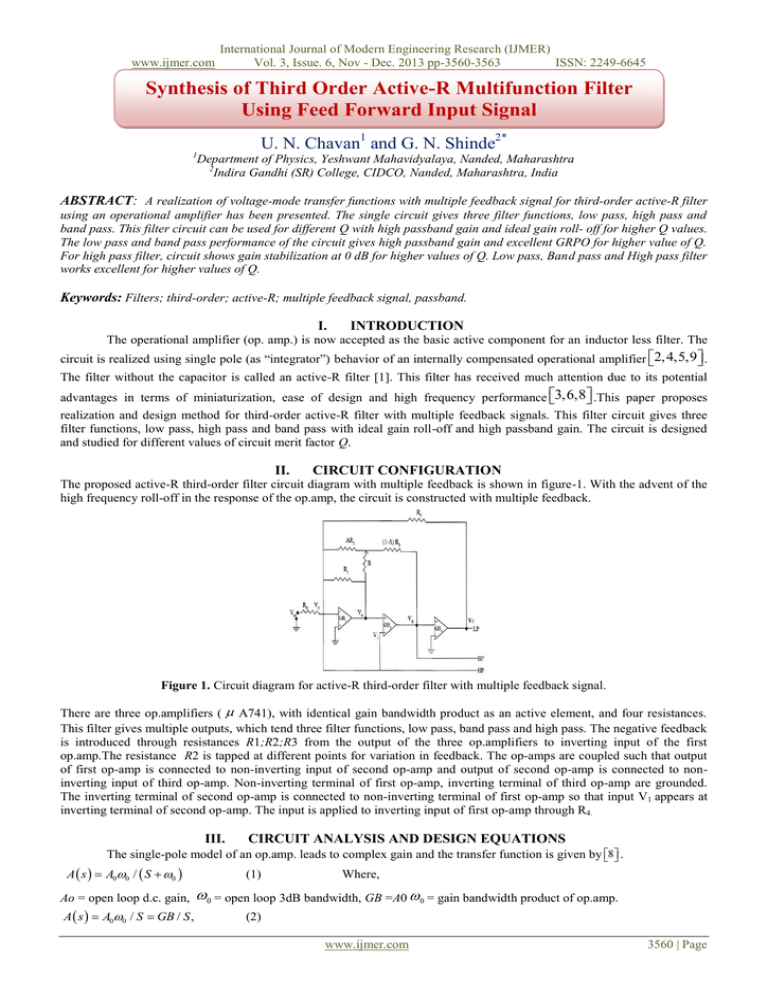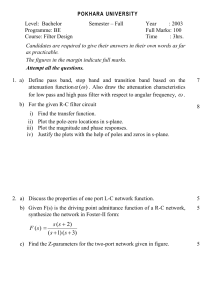Synthesis of Third Order Active-R Multifunction Filter Using
advertisement

www.ijmer.com International Journal of Modern Engineering Research (IJMER) Vol. 3, Issue. 6, Nov - Dec. 2013 pp-3560-3563 ISSN: 2249-6645 Synthesis of Third Order Active-R Multifunction Filter Using Feed Forward Input Signal U. N. Chavan1 and G. N. Shinde2* 1 Department of Physics, Yeshwant Mahavidyalaya, Nanded, Maharashtra 2 Indira Gandhi (SR) College, CIDCO, Nanded, Maharashtra, India ABSTRACT: A realization of voltage-mode transfer functions with multiple feedback signal for third-order active-R filter using an operational amplifier has been presented. The single circuit gives three filter functions, low pass, high pass and band pass. This filter circuit can be used for different Q with high passband gain and ideal gain roll- off for higher Q values. The low pass and band pass performance of the circuit gives high passband gain and excellent GRPO for higher value of Q. For high pass filter, circuit shows gain stabilization at 0 dB for higher values of Q. Low pass, Band pass and High pass filter works excellent for higher values of Q. Keywords: Filters; third-order; active-R; multiple feedback signal, passband. I. INTRODUCTION The operational amplifier (op. amp.) is now accepted as the basic active component for an inductor less filter. The circuit is realized using single pole (as “integrator”) behavior of an internally compensated operational amplifier 2, 4,5,9 . The filter without the capacitor is called an active-R filter [1]. This filter has received much attention due to its potential advantages in terms of miniaturization, ease of design and high frequency performance 3,6,8 .This paper proposes realization and design method for third-order active-R filter with multiple feedback signals. This filter circuit gives three filter functions, low pass, high pass and band pass with ideal gain roll-off and high passband gain. The circuit is designed and studied for different values of circuit merit factor Q. II. CIRCUIT CONFIGURATION The proposed active-R third-order filter circuit diagram with multiple feedback is shown in figure-1. With the advent of the high frequency roll-off in the response of the op.amp, the circuit is constructed with multiple feedback. Figure 1. Circuit diagram for active-R third-order filter with multiple feedback signal. There are three op.amplifiers ( A741), with identical gain bandwidth product as an active element, and four resistances. This filter gives multiple outputs, which tend three filter functions, low pass, band pass and high pass. The negative feedback is introduced through resistances R1;R2;R3 from the output of the three op.amplifiers to inverting input of the first op.amp.The resistance R2 is tapped at different points for variation in feedback. The op-amps are coupled such that output of first op-amp is connected to non-inverting input of second op-amp and output of second op-amp is connected to noninverting input of third op-amp. Non-inverting terminal of first op-amp, inverting terminal of third op-amp are grounded. The inverting terminal of second op-amp is connected to non-inverting terminal of first op-amp so that input V1 appears at inverting terminal of second op-amp. The input is applied to inverting input of first op-amp through R4. III. CIRCUIT ANALYSIS AND DESIGN EQUATIONS The single-pole model of an op.amp. leads to complex gain and the transfer function is given by 8 . A s A00 / S 0 Ao = open loop d.c. gain, A s A00 / S GB / S , (1) Where, 0 = open loop 3dB bandwidth, GB =A0 0 = gain bandwidth product of op.amp. (2) www.ijmer.com 3560 | Page International Journal of Modern Engineering Research (IJMER) www.ijmer.com Vol. 3, Issue. 6, Nov - Dec. 2013 pp-3560-3563 ISSN: 2249-6645 Where, S 0 This shows that the op. amp. is an “integrator”, Thus the active-R third-order filter transfer function at three different terminals are given below. The voltage transfer function for low pass filter. 1/ R4 GB1GB2GB3 TLP S X1S 3 X 2 S 2 X 3 S X 4 (3) The voltage transfer function for band pass filter 1/ R4 GB1GB2 S TBP S X1S 3 X 2 S 2 X 3 S X 4 (4) The voltage transfer function for high pass filter 1/ R4 S 3 THP S X1S 3 X 2 S 2 X 3 S X 4 (5) Where, 1 1 1 1 1 A MR X1 A R1 AR 2 R 3 R 4 1 X2 1 A R 2 M R1 X RM 3 X4 M GB1GB2GB3 R3 1 A 1 A R 22 RR 2 The circuit was designed using coefficient matching technique with general third-order filter transfer function 4,5 T S H 3 S 3 H 2 S 2 HS H 0 S S 0 1/ Q 1 S02 1/ Q 1 03 3 2 (6) By comparing (3), (4), and (5) with (6), we get the design equation as (1) R1 1 P 1 A R2 M N (2) R2 X Where (3) X X2 RN 2 PA 1 A R 2 A 1 A R3 N 3 (4) R4 1 1 1 1 1 A RM 1 R1 AR2 R3 A Values of R1; R2; R3, and R4 can be calculated using these equations for different values Q (table 1). For practical realization all values of resistances are scaled by 100. www.ijmer.com 3561 | Page www.ijmer.com International Journal of Modern Engineering Research (IJMER) Vol. 3, Issue. 6, Nov - Dec. 2013 pp-3560-3563 ISSN: 2249-6645 TABLE 1 Resistance values for different Q Q R1 R2 R3 R4 02 941 2326 1756 k 112 05 1.2 189 286 4261 5954 1756 k 1756 k 106 104 2 5 10 15 384 483 528 545 7478 8876 9477 9698 1756 k 1756 k 1756 k 1756 k 103 102 102 102 20 554 9812 1756 k 102 25 559 9882 1756 k 102 IV. DISCUSSION FOR VARIATION IN Q The circuit performance was studied with different values of Q (Q =0.2, 0.5, 1.2, 2, 5, 10, 15, 20, 25). The table 1 shows resistance values of resistance for different Q value. The circuit was studied for different values of Q for centre frequency f0=10 KHz. The observed frequency response shows good agreement with theoretical results. Following observations are noticed from experimental study at three different terminals; low pass, band pass and high pass filter function for different Q. V. RESULT AND DISCUSSION a) Low pass response: Q0.2 Q0.5 Q1.2 Q5 Q10 Q15 Q20 Q25 120 110 100 90 80 Gain (dB) 70 60 50 40 30 20 10 0 -10 100 1k 10k 100k 1M Frequency (Hz) Low Pass Response for Central Frequency 10 kHz Figure 2 - Low pass (LP) responses for different values of Q Low pass (LP) responses for different values of Q are shown in figure 2. The observed centre frequency is also in good agreement with the designed value. It is noticed that this circuit has high passband gain and it increases with increase in Q value and is constant for Q>10.Gain roll off per octave is excellent for Q>1.2. The %Change in FOL decreases with Q value. Overshoot is observed and increases for Q> 1.2. The circuit shows excellent performance for Q> 10. b) Band pass response: Q0.2 Q0.5 Q1.2 Q5 Q10 Q15 Q20 Q25 80 70 60 Gain (dB) 50 40 30 20 10 0 -10 100 1k 10k 100k Frequency (Hz) Band Pass Response for Central Frequency 10 kHz 1M Figure -3 : The band pass (BP) response for different Q, www.ijmer.com 3562 | Page International Journal of Modern Engineering Research (IJMER) www.ijmer.com Vol. 3, Issue. 6, Nov - Dec. 2013 pp-3560-3563 ISSN: 2249-6645 The band pass (BP) response for different Q is shown in figure 3. The Maximum passband gain increases with Q value. The bandwidth is slightly deviated from central frequency value. It is observed that curves are symmetric on both sides. The circuit shows excellent performance for higher values of Q. c) High pass response: Q0.2 Q0.5 Q1.2 Q5 Q10 Q15 Q20 Q25 40 30 20 10 Gain (dB) 0 -10 -20 -30 -40 -50 -60 -70 -80 100 1k 10k 100k Frequency (Hz) High Pass Response for Central Frequency 10 kHz 1M Figure -4 : High pass (HP) responses for different values of Q High pass (HP) responses for different values of Q are shown in figure 4. The response shows that GRPO is excellent and close to ideal value for higher Q values. For Q>5 gain stabilizes at o dB. The circuit shows ideal response for Q>10. VI. CONCLUSION A realization of voltage mode transfer function for a third-order active-R filter using op.amp. with multiple feedback signal has been presented. This circuit is composed only of three op. amplifiers and four resistances. Also, this single filter circuit gives three filter functions; low pass, band pass and high pass. The low pass and band pass performance of the circuit gives high passband gain and excellent GRPO for higher value of Q. For high pass filter, circuit shows gain stabilization at 0 dB for higher values of Q. Low pass, Band pass and High pass filter works excellent for higher values of Q. REFERENCES [1] [2] [3] [4] [5] [6] [7] [8] [9] HioashimuraM1992 Active-R realization of current mode high pass filter. Int. J. Electron. 73: 1279–1283 Huelsman L P 1971 Equal-valued capacitor active-RC network realisation of a 3rd order low pass Butterworth characteristics. Electron. Lett. 7: 291–293 Kadam A B, Mahajan A M 1995 Effect of positive feedback on the response of active-R filter. J. Instrum. Soc. India 25: 48–55 Mohan N, Patil R L Ripple pass function and their active-R realization. Indian J. Pure Appl. Phys. 30: 749–750 Shinde G N, Patil P B 2002 Study of active-R second-order filter using feedback at non-inverting terminals. Bull. Pure Appl. Sci. D21: 23–31 Shinde G N, Mirkute P R, Achole P D 2003 Second order active-R filter with multiple feedback for different Q. Indian J. Phys. B77: 72–80 Soderstand M A, Mitra S K 1971 Sensitivity analysis of third-order filter. Int. J. Electron. 30: 265–273 Srinivasan S 1992 Synthesis of transfer function using the operation amplifier pole. Int. J. Electron. 73: 1279–1283 Sun Zhi-Xiao 1983 Active-R filter: a new biquadratic with four terminals. Int. J. Electron. 54: 523–530 www.ijmer.com 3563 | Page



